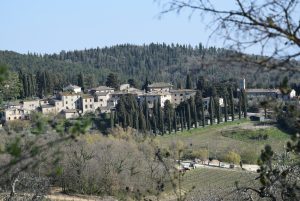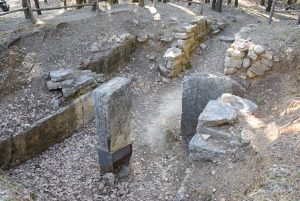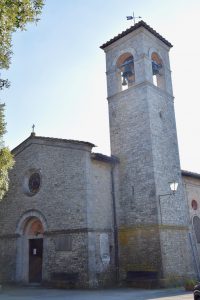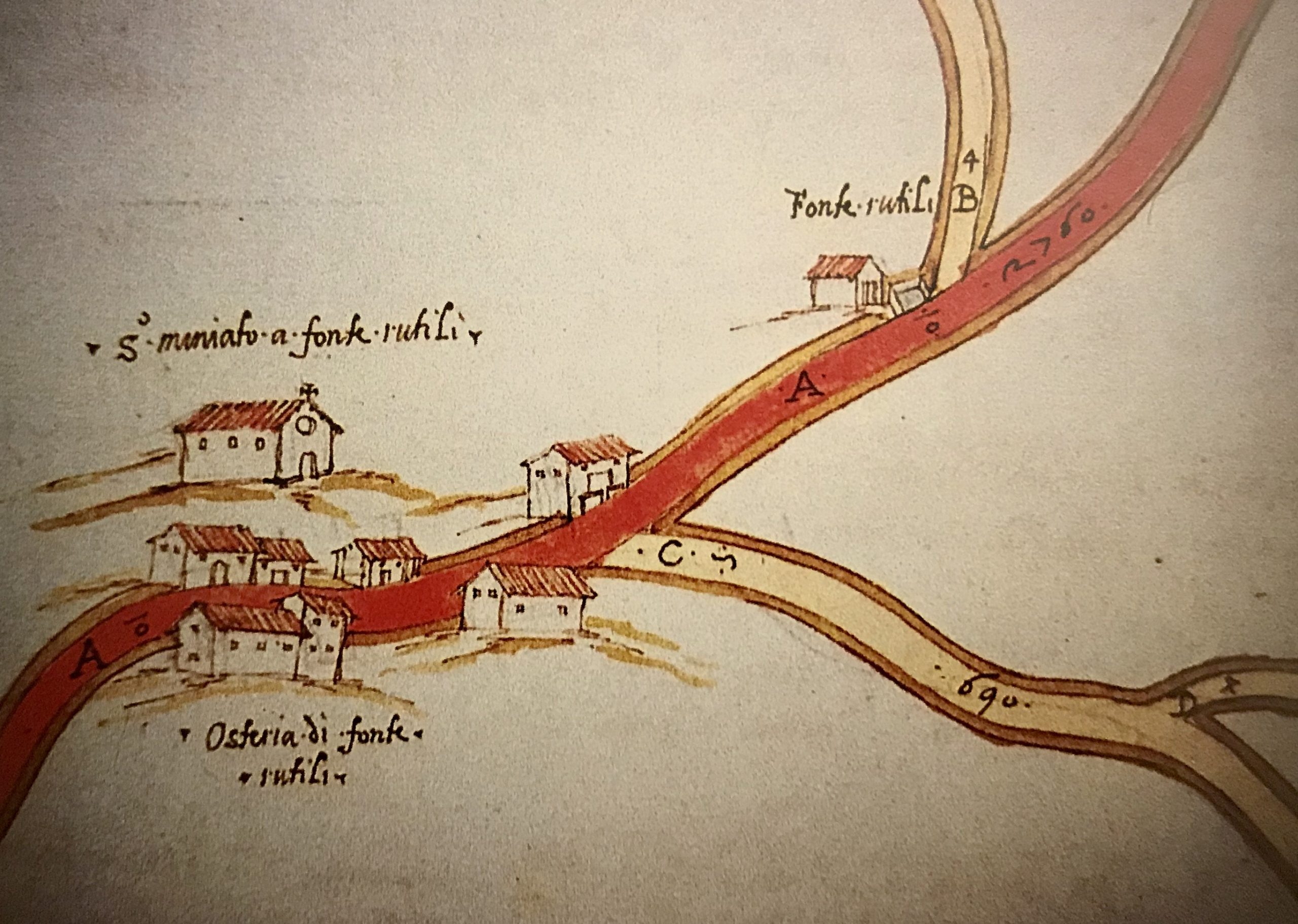by Simone Bandini
 Fonterutoli (from Fons Rutilis: ‘clear fountain’) is set at an extraordinary vantage point in the Chianti bastions that dominate the Val d’Elsa on the legendary SS222 Chiantigiana road that connects Siena and Florence, flanked for long stretches by the ancient Via Romea – a road of great historical significance – and today a well-marked path and a paradise on earth for trekkers. In addition to a bucolic walk through its narrow streets, with openings downwards and a view of the beautiful medieval castle – owned by the Mazzei family since 1435 – we recommend a visit to the Church of San Miniato and the nearby Etruscan necropolis of Poggino.
Fonterutoli (from Fons Rutilis: ‘clear fountain’) is set at an extraordinary vantage point in the Chianti bastions that dominate the Val d’Elsa on the legendary SS222 Chiantigiana road that connects Siena and Florence, flanked for long stretches by the ancient Via Romea – a road of great historical significance – and today a well-marked path and a paradise on earth for trekkers. In addition to a bucolic walk through its narrow streets, with openings downwards and a view of the beautiful medieval castle – owned by the Mazzei family since 1435 – we recommend a visit to the Church of San Miniato and the nearby Etruscan necropolis of Poggino.
In the historic and scenic heart of Chianti, with a panorama of Siena’s towers and the last buttresses of Tyrrhenian Tuscany to its West, Fonterutoli has a fascinating history, starting with the well-known Legend of the Black Rooster: it seems that here the border between the states of Florence and Siena was defined, with the advantage going to the magnificent republic that placed the border just 12 km from Siena, thanks to the cunning of its knight who left at dawn – and to a black rooster held on a stick who sang loudly and precociously compared to the actual sunrise!
 The ancient Church of San Miniato, also in Fonterutoli, was the scene of a famous agreement between the two contending territories; in March 1021 there was the annexation of Montalcino to Siena – completed in October 1208 with the exclusion of Poggibonsi and its territory. Although little remains of the ancient religious building and fortress, near the town proceeding eastwards there is the necropolis of Poggino di Fonterutoli – which bears witness to an Etruscan community that inhabited the territory between the end of the 7th century BCE up to the 5th century BCE – discovered in the 1980s by the local ‘Salingolpe’ archaeological group. The site consists of five tombs, four chamber shape and one caisson – which have been plundered by unscrupulous grave robbers over the centuries. Today four monumental structures remain visible, connected by a path that winds through the vegetation. Many objects of daily and ritual use have been found, including amphorae and ampoules, collected at the Rocca di Castellina and its mavellous Chianti Archaeological Museum.
The ancient Church of San Miniato, also in Fonterutoli, was the scene of a famous agreement between the two contending territories; in March 1021 there was the annexation of Montalcino to Siena – completed in October 1208 with the exclusion of Poggibonsi and its territory. Although little remains of the ancient religious building and fortress, near the town proceeding eastwards there is the necropolis of Poggino di Fonterutoli – which bears witness to an Etruscan community that inhabited the territory between the end of the 7th century BCE up to the 5th century BCE – discovered in the 1980s by the local ‘Salingolpe’ archaeological group. The site consists of five tombs, four chamber shape and one caisson – which have been plundered by unscrupulous grave robbers over the centuries. Today four monumental structures remain visible, connected by a path that winds through the vegetation. Many objects of daily and ritual use have been found, including amphorae and ampoules, collected at the Rocca di Castellina and its mavellous Chianti Archaeological Museum.
The Via Romea Sanese, which we dealt with in the first issue of Valley Life – Chianti and Valdelsa, passes directly from Fonterutoli descending towards Siena. There are many historical chronicles that mention it as a high road or upland connection between Florence and Siena, an alternative to the Via Francigena, which takes the valley route instead.
 We find traces of it in 1281 in the Sienese text Statutum Varium and then, in the fourteenth century, in the Statuto del Capitano del Popolo di Firenze [Statute of the Captain of the People of Florence], a sort of mapping of the main Florentine streets, as well as in the Libro vecchio di Strade [Old Book of Roads] of 1461.
We find traces of it in 1281 in the Sienese text Statutum Varium and then, in the fourteenth century, in the Statuto del Capitano del Popolo di Firenze [Statute of the Captain of the People of Florence], a sort of mapping of the main Florentine streets, as well as in the Libro vecchio di Strade [Old Book of Roads] of 1461.
Amongst the great variety of temporal and spiritual potentates that dot the history of Italy, the Holy Roman Emperor Otto III passed through here (remembered by the Edict of Fonterutoli of 998 which put an end to the territorial conflicts of the dioceses of Siena, Arezzo and Fiesole), then Pope Leo X who left Rome and stopped in Castellina to meet the freshly nominated King of France in 1515; here came the Guelph troops who came down from Florence for the Battle of Montaperti (4 September 1260) and were soundly defeated; an earthquake for the European geopolitical scenario in favour of the Empire and the Republic of Siena. We also remember how Filippo Brunelleschi passed here to remodel the fortresses of Castellina, Staggia and Rencine. We also recall, for various reasons, various famous personalities who were here for work or residence, such as Niccolò Machiavelli, Jacopo della Quercia, Lisa Gherardini and Michelangelo Buonarroti.
 Even in the contemporary period the Via Romea has attracted literary reflections, from the stories of Federigo Tozzi to the thoughts on war and human nature of Constituent Assembly deputy Giorgio La Pira.
Even in the contemporary period the Via Romea has attracted literary reflections, from the stories of Federigo Tozzi to the thoughts on war and human nature of Constituent Assembly deputy Giorgio La Pira.
For all these and various other reasons, in addition to its architectural and landscape value, Fonterutoli can be truly considered a geopolitical balcony between Florence and Siena.
Info: Castellina in Chianti Tourist Office, Via Ferruccio 40/ tel. 0577 741392/ mob. 360 1094942 / ufficioturistico@comune.castellina.si.it
